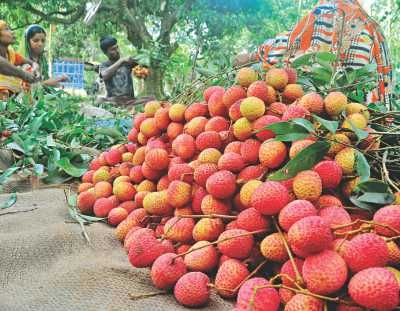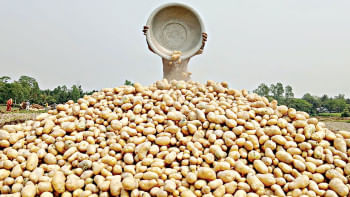<i>It's litchi time in Dinajpur</i>

Litchi farmers prepare their produce for the market at Machhimpur on the outskirts of Dinajpur town yesterday. Machhimpur is famous across the country for its quality litchis. Photo: Anisur Rahman
One may think the roads through the green, quiet northern district are adorned on purpose. Clusters of pink-red beauties sit on green leaves covering long patches of pitch-road.
It's the month of May; it's the month of litchi.
Some 430 kilometres from Dinajpur, vendors in different neighbourhoods in the capital, as elsewhere in the country, have rearranged their display with the delicious, juicy tropical fruit.
According to the Department of Agriculture Extension (DAE), litchi is being produced on 3,000 commercial orchards in 2,000 hectares of land of the district this year.
The district horticulture department expects about four tonnes of this mouthwatering fruit from each hectare.
Favourable climate is just perfect for them and there is little need for fertiliser or any pest control methods unless any natural catastrophe appears or affects the orchards.
Botanically the fruit is known as Litchi Chinensis. Dinajpur mainly grows the Bombay, Madrasi, several varieties of China and Bedana litchis, each of which weighs around 15 to 20 grams and produces around six milliliter of juice, officials said.
Each full-grown tree can produce 5,000 to 10,000 pieces of litchi every year.
Dinajpur litchis are a key to the country's agricultural growth, largely benefiting the economy of the district's rural area.
It is a trade worth Tk 120 crore, with job opportunities for a large number of people of the district, said Moududul Haque, a horticulturist of Dinajpur, saying it undoubtedly contributed to the country's economy.
During a visit to a litchi market in Dinajpur town on Saturday morning, this correspondent saw growers from every corner of the district gathering their litchi by hired transport at the local market for sale.
Buyers from across the country were seen busy procuring them to meet the demands of their respective districts.
“We're selling every 100 pieces of Bombay and Madrasi litchi at Tk 230 to 320, depending on the size," said Altafuzzaman, a vendor at Dinajpur litchi market.
The production, however, fell this year by about 40 percent due to unfavourable weather, traders said.
“I leased an orchard of 26 trees at Tk 70,000, and I'm expecting a profit of Tk 1,00,000 this season. The profit was about Tk 1.5 lakh last year from the same orchard," said Masud Parvez of Hariharpur under Dinajpur sadar upazila.
The litchi season is also an income generator for the locals, including women and children.
Azizur, who was busy plucking the litchi, said he earned Tk 25 for plucking every 100 litchis while women were sorting each 100 pieces for Tk 10.
"It's a seasonal job to make money," said Razia Begum of Masimpur village of sadar upazila.
Above all, this luscious ruby-red, heart-shaped litchi is a symbol of love and romance and they invite many tourists every year to the region, said Anwarul Alam, deputy director of Dinajpur Agriculture Department.

 For all latest news, follow The Daily Star's Google News channel.
For all latest news, follow The Daily Star's Google News channel. 



Comments